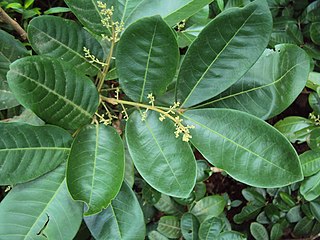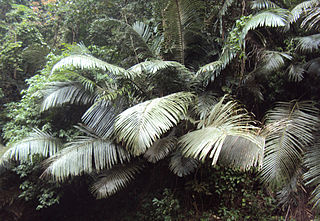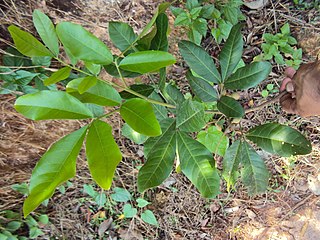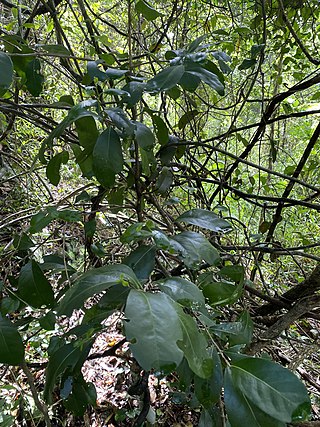
Aglaia is a genus of 121 recognised species of woody dioecious trees in the mahogany family Meliaceae. They occur in the subtropical and tropical forests of Southeast Asia, northern Australia and the Pacific.

Arenga wightii is a species of flowering plant in the family Arecaceae. It is native to the Southern Western Ghats in Kerala in India. This palm has various uses in its communities. Local tribal communities depend on this plant for starch and religious ceremonies. It is also used to cover the roofs of houses due to its string resemblance to coconut leaves. Scientists have discovered that this palm has medicinal value. It is said to have antimicrobial and antioxidant phytochemicals. It is threatened by habitat loss.
Aglaia apiocarpa is a species of plant in the family Meliaceae. It is found in Southern India and Sri Lanka.
Aglaia archboldiana is a species of plant in the family Meliaceae. It is endemic to Fiji.

Aglaia argentea is a species of plant in the family Meliaceae. It is a tree found in Australia, Brunei, India, Indonesia, Malaysia, Myanmar, Papua New Guinea, the Philippines, the Solomon Islands, and Thailand.
Aglaia australiensis is a species of plant in the family Meliaceae. It is endemic to Australia.
Aglaia basiphylla is a species of plant in the family Meliaceae. It is endemic to Fiji.
Aglaia cinnamomea is a species of plant in the family Meliaceae. It is found in Papua, Indonesia and Papua New Guinea. Although it was treated as a separate species in a 1998 assessment by the IUCN Red List, other sources include it within Aglaia elliptica.

Aglaia elaeagnoidea, the droopy leaf or priyangu, is a species of plant in the family Meliaceae. It is a 10m tall tree found in American Samoa, Australia, Cambodia, China, India, Indonesia, Malaysia, New Caledonia, Papua New Guinea, the Philippines, Samoa, Sri Lanka, Taiwan, Thailand, Vanuatu, and Vietnam.
Aglaia foveolata is a species of tropical tree in the family Meliaceae. This plant occurs in Brunei, Indonesia, and Malaysia. It produces edible fruit. The bark contains silvestrol which is a potent inhibitor of ebola virus and Zika Virus replication.
Aglaia gracilis is a species of plant in the family Meliaceae. It is endemic to Fiji.

Aglaia lawii is a species of tree in the family Meliaceae. As well as the autonym species, there are two subspecies accepted.
Aglaia malabarica is a species of plant in the family Meliaceae. It is endemic to Kerala, India.

Aglaia rimosa is an evergreen small tree in the family Meliaceae. It is found in Indonesia, Papua New Guinea, the Philippines, and Taiwan. Aglaia rimosa "grows primarily in the wet tropical biome".The official name of Aglaia rimosa in Taiwan is Large-leaved aglaia, because compared with the other two species native to Taiwan, Aglaia elaeagnoidea and Aglaias chittagonga, the leaflet of Aglaia rimosa is larger than their leaflet, all three are imparipinnate.The flowers of Aglaia rimosa have fragrance, but it is lighter than that of Aglaia odorata.The anticancer compound Rocaglamide (RocA) was originally extracted from Aglaia rimosa by researchers in Taiwan.

Aglaia tomentosa is a species of plant in the mahogany family Meliaceae. It is found in Brunei, India, Indonesia, Laos, Malaysia, the Philippines, Singapore, and Vietnam.

Fissistigma is a genus of flowering plants in the family Annonaceae. There are about 75 species distributed in Africa, Asia and Oceania.

Mangifera odorata, commonly known as kwini, huani, or Saipan mango, is a species of plant with edible fruit in the family Anacardiaceae. It is similar to the related mango but is characterized by a strong turpentine-like smell on the skin and fibrous flesh. It is native to tropical Southeast Asia, but its exact original native range is unknown because it is only known from cultivated specimens and is believed to be a hybrid of Mangifera indica and Mangifera foetida. It is grown throughout Southeast Asia, from peninsular Thailand, to Malaysia, Indonesia and the southern Philippines. It has also been occasionally cultivated in southern Vietnam and the Marianas Islands.
Siphonodon celastrineus is a species of plant in the family Celastraceae. It is found in Cambodia, India, Myanmar, and Vietnam.

Siphonodon is a small genus of flowering plants in the family Celastraceae.

Caryota obtusa is a species of flowering plant in the palm family Arecaceae. It is native to India, Laos and Thailand. The palm is commonly called giant fishtail palm or Thai giant caryota. It can reach 20 meters or more in height and is thus considered a tree. It is monocarpic meaning it flowers once, then dies. Its inflorescence can reach 6 meters or more in length.











